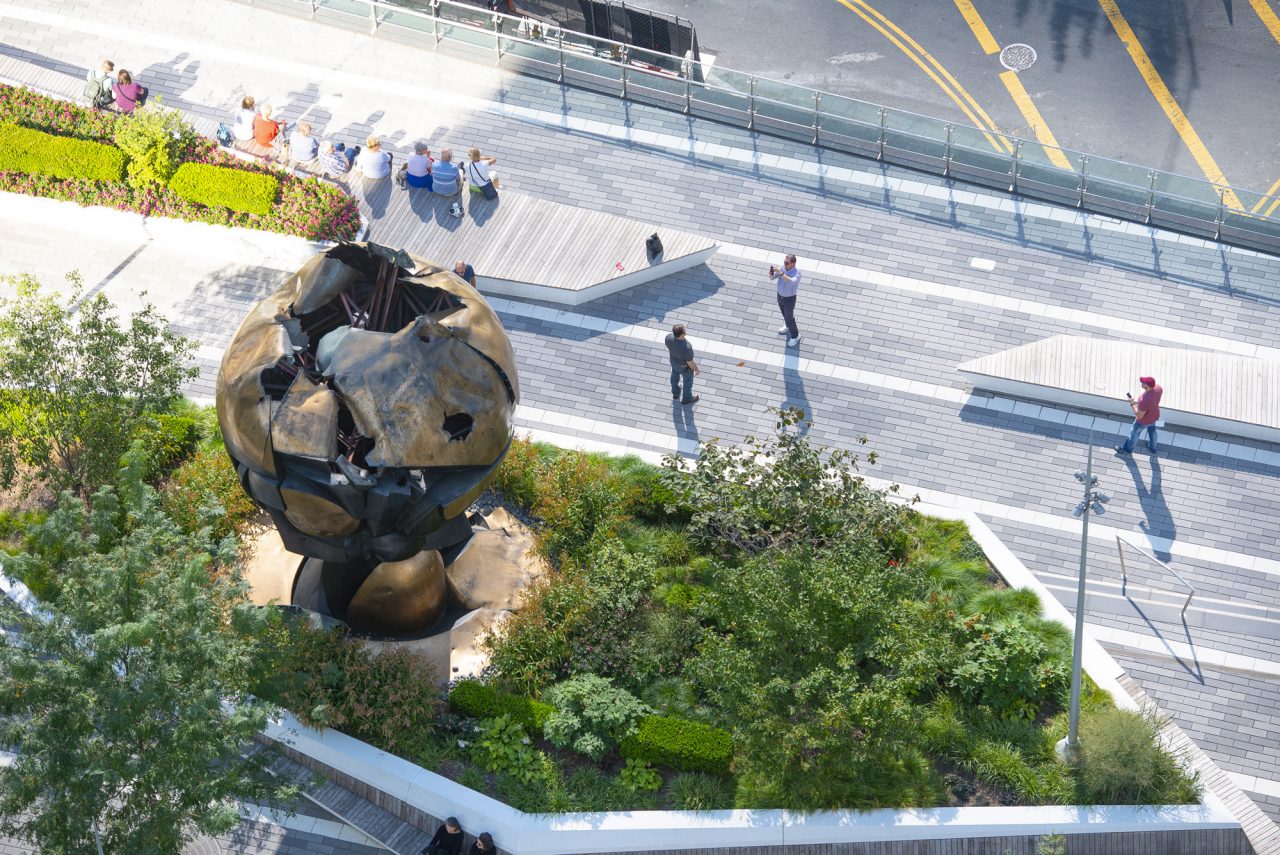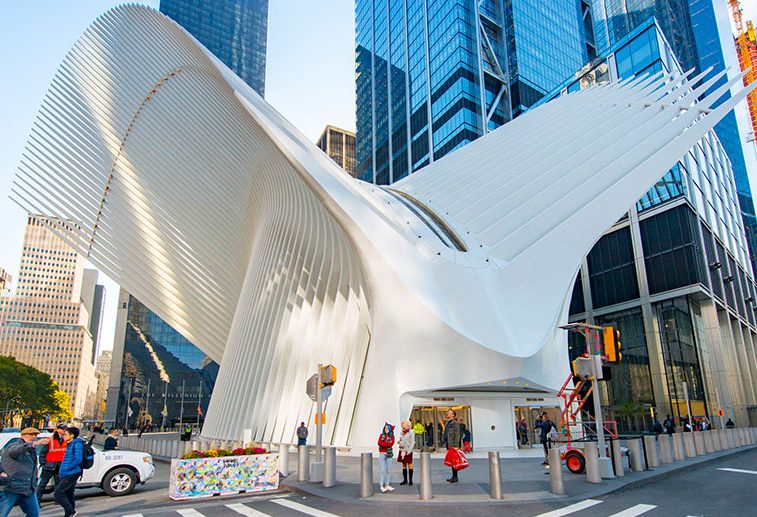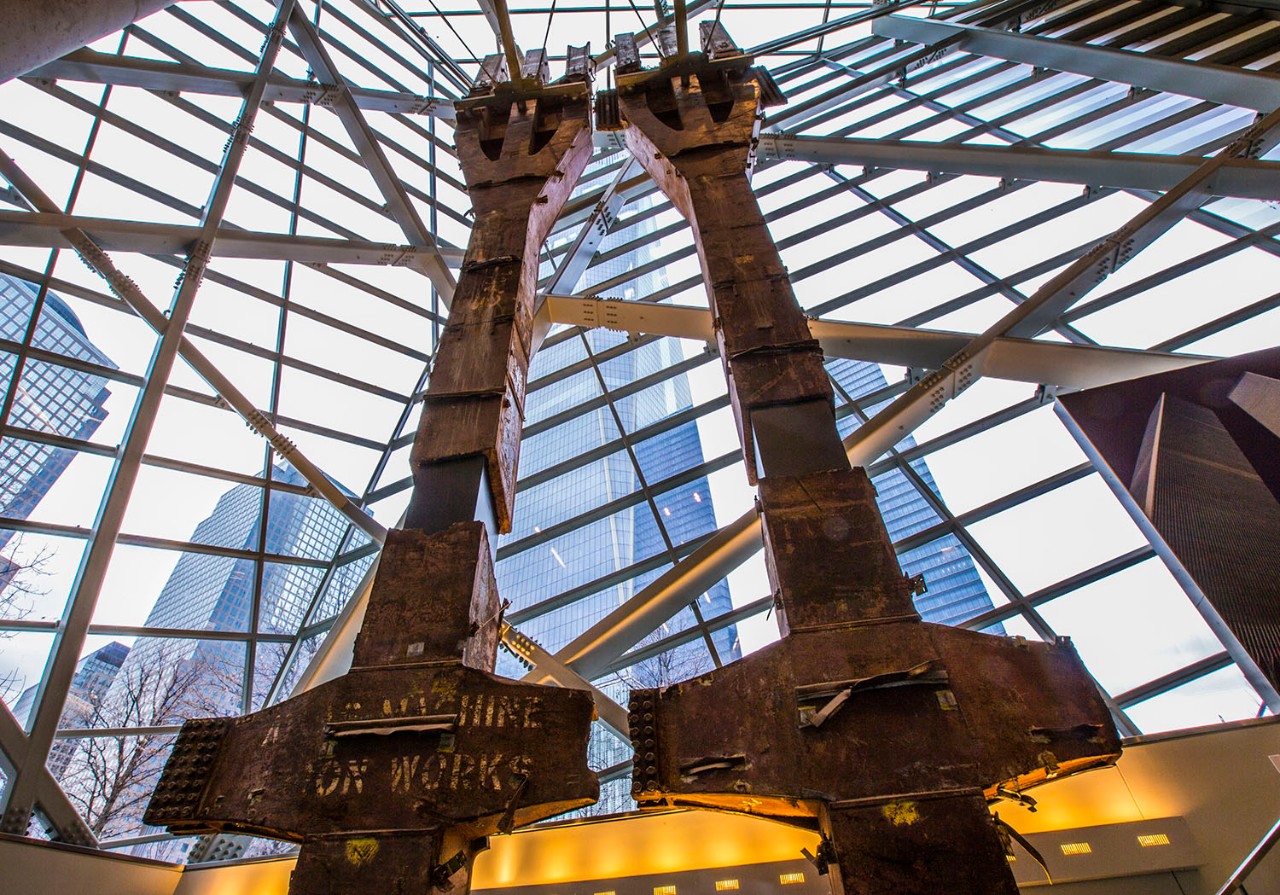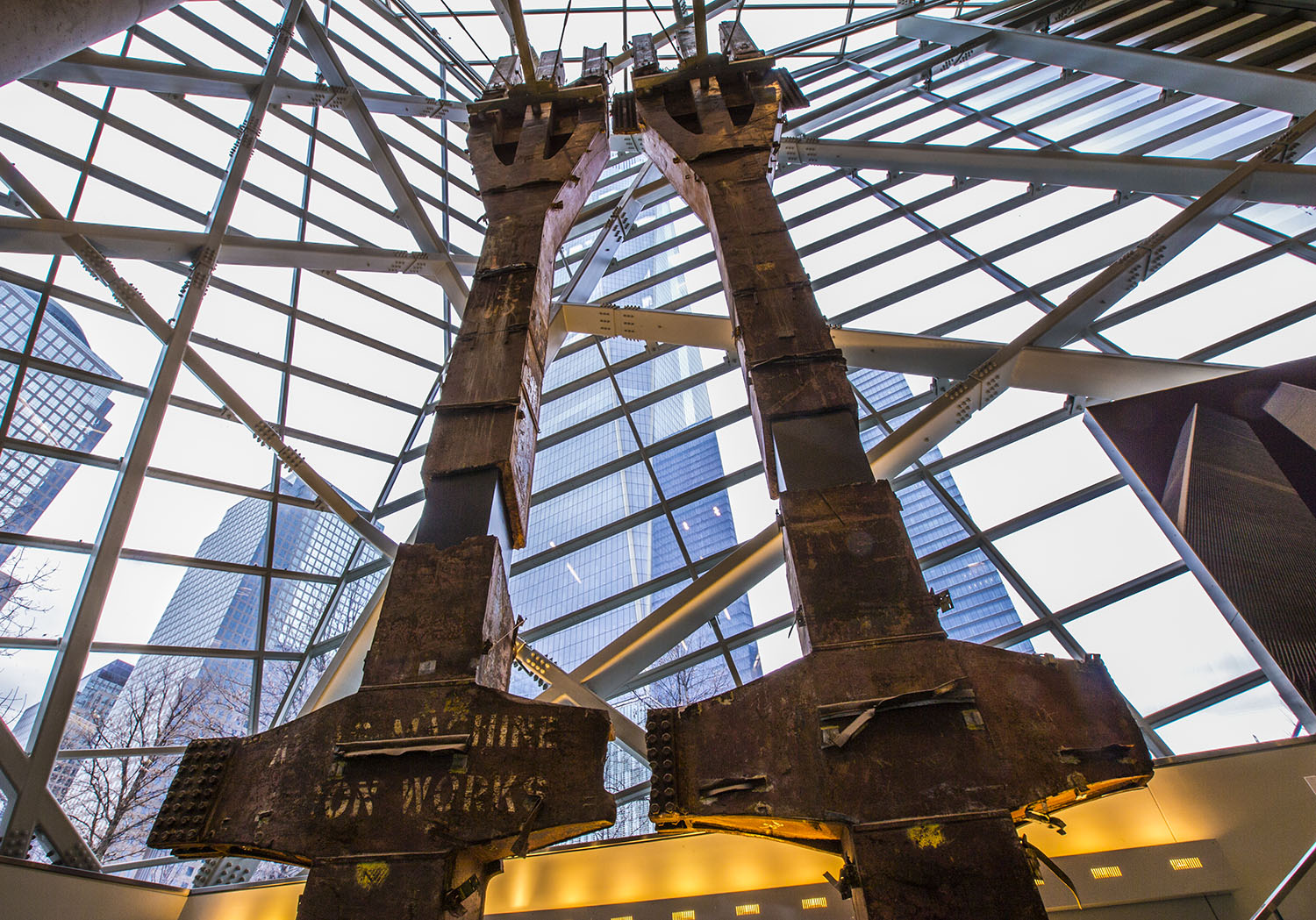Tour These 9/11-Related Points of Interest at the WTC
At the World Trade Center, the National September 11 Memorial & Museum is a center for remembrance and reflection. However, throughout the entire 16-acre campus, you’ll find that our buildings, statues, installations, and even corridors, connect to the legacy of this historic place and its status as an international landmark. Learn below about these points of interest, from the famous Koenig Sphere to the historic E Train Subway Corridor. If interested in the self-guided walking tour, it takes around 90 minutes, depending on how long you want to spend at each location.
Liberty Park Points

Koenig Sphere
The Port Authority of New York and New Jersey commissioned German artist Fritz Koenig to create the Koenig Sphere (originally titled “Große Kugelkaryatide N.Y.”) as a symbol of world peace through world trade. It was placed at Austin J. Tobin Plaza between the Twin Towers in the early 1970s. Following September 11, 2001, the “Sphere” took on new meanings of hope and resilience when it was recovered from the rubble at Ground Zero and temporarily relocated to Battery Park. The “Sphere” returned to the World Trade Center’s Liberty Park in 2017.
Anne Frank Tree
The Anne Frank Tree was grown from a sapling of the tree that grew outside the Secret Annex where Anne Frank and her family hid from 1942 to 1944 during the Nazi occupation of Amsterdam. While in hiding, Anne Frank kept a diary in which she wrote her hopes for the future while looking upon the tree from her window.
The Anne Frank Center for Mutual Respect planted the Whitehorse chestnut sapling in Liberty Park in 2016. It was one of 11 donated as part of the “Sapling Project,” an initiative to donate saplings from the original tree outside the annex to places of significance around the United States, including at the U.S. Capitol grounds. The Anne Frank Tree at the World Trade Center was formally dedicated on June 12, 2017, Anne Frank’s birthday.
America’s Response Monument
Artist Douwe Blumberg created “America’s Response Monument” to honor the U.S. Army Special Forces, Special Operations Forces, Central Intelligence Agency, and other inter-agency teams who were called to serve following the attacks on September 11, 2001. The statue represents the American Green Berets who rode horseback (the first time American troops to have done so in 50 years) into Afghanistan in October 2001. “America’s Response Monument” made its debut at the New York City Veterans Day Parade in 2011 before finding its permanent home here in Liberty Park, following a dedication ceremony in 2016.
Saint Nicholas Greek Orthodox Church & National Shrine
Designed by Santiago Calatrava, architect of the Oculus, the Saint Nicholas National Shrine replaces the former St. Nicholas Greek Orthodox Church that was destroyed on September 11, 2001. Calatrava’s design was inspired by the Byzantine churches from Istanbul’s Hagia Sophia and the Church of the Holy Saviour in Chora.
The St. Nicholas National Shrine is located on the east side of Liberty Park and is expected to open to the public starting in late 2022 or early 2023. It will welcome people of all faiths as a center of remembrance and contemplation.
Oculus

The Oculus
Before 9/11, the World Trade Center connected major transportation lines, including the PATH Train and MTA NYCT Subway, serving as a multi-modal hub for Lower Manhattan. Upon rebuilding, it was essential for the campus to once again become a central connection point and gateway to Lower Manhattan and to the rest of New York City.
The Oculus, which fully opened to the public in August 2016, not only serves that purpose of connection but also is an architectural marvel. When Santiago Calatrava designed the Oculus, he was inspired by the image of a bird being released from a child’s hands. The transportation hub attracts hundreds of thousands of visitors each year who come to take pictures of the unique structure, explore the shopping and dining options, and commute from all over the region.
Twin Towers Steel Foundation
The World Trade Center PATH Station contains a few historical elements connecting back to 9/11. On the Track 5 Platform, the original steel beams from the North Tower footprint are visible under glass floor panels. There are also floor markers that represent the footprint and column bases of the South Tower across a few of the World Trade Center PATH Station platforms.
The Slurry Wall
Built in the 1960s ahead of the construction of the original World Trade Center, the Slurry Wall was designed as a sort of reverse bathtub to stop the entry of water from the Hudson River into the World Trade Center site and allow for excavation down to bedrock.
After 9/11, the wall was damaged, but held, which kept the PATH and Subway tubes from flooding. Today, the wall is visible from a few places on campus, including the World Trade Center PATH Station and in the 9/11 Memorial Museum.
E Train Subway Corridor and First Responder Door
The E Train Subway Corridor connects the Oculus to the MTA NYCT E Train platform, serving the same function it did prior to 9/11. It also retains the same design and appearance it had prior to 9/11. Many of the materials in the area, including the travertine floor, signage, doors, and other fixtures, were preserved from the original World Trade Center.
The First Responder Door within the corridor was marked by first responders during the search and recovery efforts following 9/11. Massachusetts Task Force 1 (MATF1) painted the door to mark that their team searched it on September 13, 2001, with the “X” indicating the area remained unsafe.
WTC Cortlandt 1 Train Station
Destroyed on 9/11, the MTA NYCT’s Cortlandt Train Station on the No. 1 line at the World Trade Center reopened on September 8, 2018 . The platform walls feature a mosaic titled “CHORUS,” created by Ann Hamilton.
Commissioned by the MTA, the work is made up of white marble tiles that spell out text from the 1776 Declaration of Independence and the 1948 United Nations Universal Declaration of Human Rights.
9/11 Memorial and Museum
9/11 Memorial Pools
The 9/11 Memorial Pools sit in the footprint of the Twin Towers. They were designed by Michael Arad and Peter Walker, who submitted the design titled, “Reflecting Absence,” as part of the international competition to create a permanent 9/11 memorial at the World Trade Center. The pools, which opened on September 11, 2011, are almost an acre each and contain the largest man-made waterfalls in North America. The names of the 2,977 killed on September 11, 2001, and the six people killed on February 26, 1992, are inscribed along the pools’ edging.
9/11 Memorial Glade
The 9/11 Memorial Glade is a monument dedicated to the first responders, recovery workers, survivors, and community members who have suffered or died from illness following September 11, 2001. Designed by Michael Arad and Peter Walker, the architects of the 9/11 Memorial, the Glade features a pathway flanked by six stone monoliths inlaid with original World Trade Center steel. The 9/11 Memorial Glade was dedicated on May 30, 2019, the 17th anniversary of the official end of 9/11 recovery efforts.
The Survivor Tree
After 9/11, recovery workers found a damaged Callery pear tree at Ground Zero. The New York City Parks and Recreation Department nursed the tree back to health, and upon its return to the World Trade Center in 2010, the tree became known as a symbol of resilience and was called “The Survivor Tree.”

9/11 Memorial & Museum
The 9/11 Memorial & Museum illustrates the history of 9/11 and the 1993 World Trade Center bombing through curated exhibits and artifact displays. Designed by Snøhetta, the entry Pavilion displays original steel tridents from the Twin Towers. Davis Brody Bond designed the belowground Museum spaces where the Survivors' Stairs is housed.












